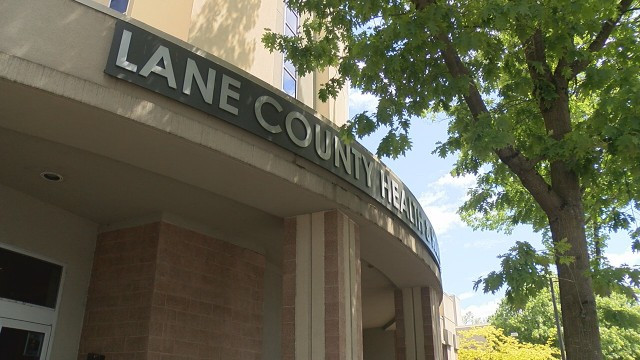
April 10, 2021 — Throughout the COVID-19 pandemic, one of the talking points has been concerns about mental health. With so many people working from home and students enrolling in comprehensive distance learning, how were people coping with isolation and stress?
Roger Brubaker, MPH, Senior Community Health Analyst with Prevention Lane, is one of the people following research on how the past year has impacted people’s mental health in Lane County.
As a branch of Lane County Public Health (LCPH), Prevention Lane’s mission is to lead efforts to plan, promote and create the optimal social environmental conditions for community health and well-being. Its main areas of focus are alcohol, prescription drugs, tobacco, nutrition, physical activity, gambling, suicide, mental health and health equity.
Prevention Lane also gathers data on different health outcomes within the county. Some of that information has been compiled in the Community Health Improvement Plan and Community Health Needs Assessment, which “document the full scope of human health in the county to the best of our ability with the data we’ve gathered,” Brubaker said.
The agency works not only with other branches of LCPH, but also with the Oregon Health Authority (OHA) and state programs as it gathers data. One aspect of that research was released in March, showing some important information regarding suicide in the state.
“There has been a lot of misinformation swirling around suicide for the past year,” Brubaker said. “OHA has now come out with the data to demonstrate that the suicide rate has not increased during the pandemic. Locally, here in Lane County, we’ve had a 20 percent reduction from 2019. Statewide, we similarly had a 15 percent reduction in the number of suicide deaths. That’s important news.”
The risk of increased suicide rates has been one of the rationales circulating for people wanting an earlier return to in-person education at k-12 schools, with people referencing students’ mental health.
“That is completely off. Because if that was the case, then suicide would have increased,” Brubaker said. “They actually decreased. … It’s really important that we have accurate, clear information about suicide. We’re talking about people’s lives. It’s not just something we can throw around.”
It was important for him to emphasize this point — that there are elements of hope.
“There’s a little bit of panic about suicide sometimes. I want to make sure that people don’t feel that. Personally, because I’ve worked with so many people who are chronically suicidal, when they hear about big national trends around suicide, it actually impacts them quite deeply. It makes them feel very hopeless about the world because of their own experiences. When we’re getting accurate information, we’re making very definitive steps to helping people,” Brubaker said.
OHA’s release stated, “According to preliminary data, there were about 90 fewer suicides across all ages in Oregon in 2020 than in 2019. … In addition, the number of suicide-related visits to emergency departments and urgent care centers in January 2021 were similar to the final quarter of 2020, and the number of suicide-related calls to Oregon Poison Center in January 2021 were similar to the final quarter of 2020. The percent of suicide-related visits to emergency departments and urgent care centers in January 2021 was similar to the final quarter of 2020.”
OHA’s data has brought a sense of relief for public health workers in Lane County as they work to not only address mental health but the other effects of the COVID-19 pandemic.
“I think it’s wonderful news,” Brubaker said. “There’s still distress and suffering, but people are living. And that’s the opportunity. It may not be a sunny day, but I see some sun poking through.”
Despite the actual decrease in deaths by suicide, people’s stress levels continue to be high, however.
“All the research, beyond the anecdotal, is pointing to a pretty significant increase in which people who have had mental health problems in the past are feeling them more frequently and more intensely,” Brubaker said. “And people who have never had mental health problems in the past are now experiencing them for the first time. That occurs every day, but to occur at this level is pretty astounding.”
Even with these high stress levels, there are two main reasons why suicide numbers have decreased during the pandemic.
“What we know about national crises is that when they occur, the suicide rate drops,” Brubaker said. “It’s been a pretty consistent phenomenon across large populations since we’ve recorded these types of things. We actually expected we would see this decline.”
He said the second reason is that people don’t necessarily have the opportunity to act on their suicidal thoughts.
“We’re seeing less suicidal behavior, but we’re not seeing less stress,” he said.
That’s where Prevention Lane and its community partners can provide some guidance.
According to Brubaker, the first step is acknowledging declining mental health.
“For those who have worsening symptoms, or those who are new to them, this is going to feel quite different, new, strange and awkward. And we might not actually be prepared or familiar with how to respond or what to do,” he said.
Once people understand they need to engage with their mental health, they can reach out for help.
“Hopefully, we live in places where we feel comfortable, confident and safe acknowledging the changes in our mental health and can have conversations to share about it with others. But if we don’t feel comfortable sharing, there’s a ton of resources that have moved online,” he said.
Online support can be effective in the short term, including telebehavioral health services. Several programs are more accessible now than they were before the pandemic. A short list of some of these options is included at the end of this article.
“Those can really help people who are in great distress and who are suffering,” Brubaker said.
Prevention Lane also recommends clinical care and therapy for people.
In addition, Brubaker said that there are peer support services.
“Maybe they’re just looking to have a conversation with somebody else that doesn’t identify as a professional but who went through something like they did. And then you’re just talking to some guy,” he said.
As for Prevention Lane, it has its own partners in the community, including Suicide Prevention Coalition of Lane County, the Community Support Team-Mobile Crisis Response at Siuslaw Valley Fire and Rescue, Healthy Directions Lane County and the National Alliance on Mental Illness (NAMI).
It also works closely with school districts across the county. At the end of this month, Prevention Lane will be conducting a two-day Applied Suicide Intervention Skills Training (ASIST) workshop with Mapleton and Siuslaw school districts.
Both districts are among 12 rural schools who received a youth suicide prevention grant to support the implementation of Adi’s Act, also known as Senate Bill 52. Passed in 2019, Adi’s Act requires Oregon school districts to develop comprehensive district Student Suicide Prevention Plans.
The plans will include procedural planning, equity and racial equity-centered supports, and a staff training process that explicitly addresses when and how students and families are referred to appropriate mental health and crisis services.
“We’re helping them with implementing evidence-based strategies, like screening, assessment and safety planning practices, that help them apply the standard of care to each of the students that they identify in their school that are at risk of suicide,” Brubaker said.
Adi’s Act operates in conjunction with the Student Success Act to ensure that LGBTQ+ (lesbian, gay, bisexual, transgender, queer) youth; foster youth; youth with disabilities; Black, Indigenous and people of color communities; and historically underserved youth receive equitable access to services and support.
The ASIST workshop will take place locally on April 21 and 22. The participants, limited to around 10, will include staff from Siuslaw and Mapleton districts, PeaceHealth and the Mobile Crisis Response team.
“Although our focus is the school, we’re doing these trainings very small because of the pandemic,” Brubaker said. “We would love to have even more partners, because when we get them all in the room working and training together, they really learn together and start sharing ideas across the systems.”
The workshop is considered advanced training, beyond the more basic QPR (Question, Persuade and Refer) training, one of the most widely taught suicide prevention trainings in the world.
“ASIST is a two-day, pretty intensive process in which we really work with participants as they interrogate their own beliefs and thoughts around suicide; how they influence and work with people who are at risk of suicide; and then how they can do thoughtful interventions that meet those needs,” Brubaker said. “That takes a good two days, which is two days of fully focusing on suicide interventions.”
Beside the ASIST workshop, Prevention Lane works with the 12 schools in the grant coalition to talk about the four-year scope of the project.
“This workshop, and any training we do, is really step one in terms of setting up systems that are sustainably and continuously prepared, and not just individuals that are knowledgeable and confident,” Brubaker said. “Influencing systems is the bigger haul. That’s why this is actually a four-year grant that we’re working on. All that work recognizes how long it takes to implement and get it all completed.”
For more information about Prevention Lane and its mental health data, visit preventionlane.org.
If you or someone you know is experiencing a mental health crisis, please know that help is available:
- Call the National Suicide Prevention Lifeline 24/7, run by Lines For Life, at 800-273-8255 or text “273TALK” to 839863 (text services available Monday–Friday, 2–6 p.m. Pacific Time). The Veterans Crisis Lines can be reached by calling the above number and pressing “1.” En español: 1-888-628-9454. TTY: Dial 711 then 1-800-273-8255. People can also visit www.linesforlife.org.
- YouthLine is a teen-to-teen crisis and help line. Teens are available to help daily from 4–10 p.m. Pacific Time (off-hour calls answered by Lines for Life). Call 877-968-8491, text “teen2teen” to 839863 or chat at oregonyouthline.org.
- Crisis Services by Oregon County are available at www.oregon.gov/oha/ph/PreventionWellness/SafeLiving/SuicidePrevention/Pages/crisislines.aspx.
- The Safe + Strong website and helpline operate 24/7 at www.safestrongoregon.org and 1-800-923-4357. Safe + Strong is designed to support people who are facing challenges related to COVID-19 or other life stressors. Use the website as a tool to help make sense of what you’re going through and to learn more about what resources and support can help you, your loved ones, and the communities you live and work in.
- If there is imminent danger to self or others, people should call 9-1-1 immediately.
Other Resources:
- 90by30 Lane County: 541-346-7484, 90by30.com
- Community Support Team-Mobile Crisis Response: 541- 997-3212, www.svfr.org/community-support-team-cst
- Live Healthy Lane: LiveHealthyLane.org
- National Alliance on Mental Illness (NAMI): www.nami.org. HelpLine can be reached Monday through Friday, 7 a.m. to 5 p.m., at 1-800-950-6264 or [email protected]
- National Sexual Assault Hotline: 1-800-656-4673, online.rainn.org
- National Teen Dating Abuse Helpline: Phone: 1-866-331-9474, Text: LOVEIS to 22522, www.loveisrespect.org
- Oregon YouthLine, teen2teen crisis helpline: Phone: 877-968-8491, Text: teen2teen to 839863, [email protected]:org, oregonyouthline.org
- Prevention Lane: preventionlane.org
- Safe Shelter for Siuslaw Students: 541-590-0779, SafeShelterforSiuslawStudents.org
- Substance Abuse and Mental Health Services Administration: Treatment in your area: 1-800-662-HELP (4357), findtreatment.samhas.gov
- The Trevor Project, Suicide Prevention Lifeline for LGBTQ youth: 1-866-4-u-Trevor (866-4887386), thetrevorproject.org
- Veterans Crisis Line: 1-800-273-8255 press #1, www.veteranscrisisline.net
- Western Lane Health Network: westlanehealth.org








